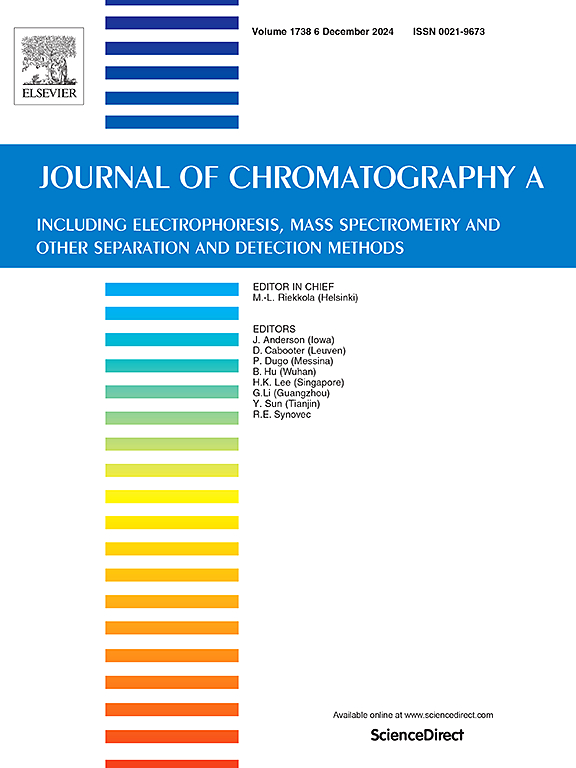Magnetic multi-template Molecularly imprinted polymers for solid-phase extraction of alkaloids in subprostrate sophora
IF 3.8
2区 化学
Q1 BIOCHEMICAL RESEARCH METHODS
引用次数: 0
Abstract
In this study, magnetic multi-template molecularly imprinted polymers (MMIPs) are successfully synthesized. The synthesis is carried out by a multi-template surface imprinting strategy using mesoporous silica-coated magnetic graphene oxide as the support material, matrine (MT), oxymatrine (OMT) and sophocarpine (SC) as the templates, 4-vinylbenzoic acid as the functional monomer, and ethylene glycol dimethacrylate (EDGMA) as the cross-linker. The MMIPs were characterized using Fourier-transform infrared spectroscopy, X-ray diffraction, scanning electron microscopy, and transmission electron microscopy. The maximum adsorption capacity of the prepared MMIPs was found to be 9.01, 20.87, and 7.76 mg/g for MT, OMT, and SC, respectively, demonstrating higher adsorption capacity compared to the non-imprinted polymers (MNIPs). Furthermore, MMIPs were utilized as adsorbents for magnetic solid-phase extraction (MSPE) in conjunction with pressurized capillary electrochromatography (pCEC) for the simultaneous separation and detection of MT, OMT, and SC in the Chinese herbal medicine substrate sophora. The factors affecting the extraction efficiency of MSPE, including the type of elution solvent, amount of adsorbent, pH of the sample solution, elution time, and eluent volume, were optimized. The MMIPs-pCEC method demonstrated a satisfactory linear response within the concentration range of 1–50 µg/mL for the three alkaloids, with correlation coefficients ranging from 0.9923 to 0.9972 and limits of detection ranging from 0.09 to 0.73 µg/mL. The findings of the present study demonstrate that MMIPs have important applications in the analysis of active ingredients in traditional Chinese medicine.
磁性多模板分子印迹聚合物固相萃取苦参中生物碱
本研究成功合成了磁性多模板分子印迹聚合物(MMIPs)。以介孔二氧化硅包覆磁性氧化石墨烯为支撑材料,苦参碱(MT)、氧化苦参碱(OMT)和槐果碱(SC)为模板,4-乙烯基苯甲酸为功能单体,乙二醇二甲基丙烯酸酯(EDGMA)为交联剂,采用多模板表面印迹策略进行了合成。采用傅里叶变换红外光谱、x射线衍射、扫描电镜和透射电镜对MMIPs进行了表征。制备的MNIPs对MT、OMT和SC的最大吸附量分别为9.01、20.87和7.76 mg/g,与非印迹聚合物(MNIPs)相比,表现出更高的吸附能力。此外,利用MMIPs作为吸附剂,结合加压毛细管电色谱(pCEC),对中药底物苦参中的MT、OMT和SC进行了同时分离和检测。考察了洗脱溶剂类型、吸附剂用量、样品溶液pH、洗脱时间、洗脱液体积等因素对MSPE萃取效率的影响。MMIPs-pCEC方法在1 ~ 50µg/mL的浓度范围内具有良好的线性响应,相关系数为0.9923 ~ 0.9972,检出限为0.09 ~ 0.73µg/mL。本研究结果表明,MMIPs在中药有效成分分析中具有重要的应用价值。
本文章由计算机程序翻译,如有差异,请以英文原文为准。
求助全文
约1分钟内获得全文
求助全文
来源期刊

Journal of Chromatography A
化学-分析化学
CiteScore
7.90
自引率
14.60%
发文量
742
审稿时长
45 days
期刊介绍:
The Journal of Chromatography A provides a forum for the publication of original research and critical reviews on all aspects of fundamental and applied separation science. The scope of the journal includes chromatography and related techniques, electromigration techniques (e.g. electrophoresis, electrochromatography), hyphenated and other multi-dimensional techniques, sample preparation, and detection methods such as mass spectrometry. Contributions consist mainly of research papers dealing with the theory of separation methods, instrumental developments and analytical and preparative applications of general interest.
 求助内容:
求助内容: 应助结果提醒方式:
应助结果提醒方式:


